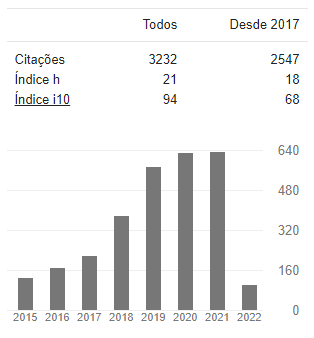IDENTIFICATION OF END OF LIFE ON LITHIUM-ION BATTERIES CELLS THROUGH SUPPORT VECTOR MACHINES FOR IN-CHARGER BATTERY MANAGEMENT SYSTEM STRATEGY
DOI:
https://doi.org/10.15628/holos.2020.9822Palabras clave:
Battery, Electric vehicles, Battery Management Systems, Wavelet transform, Support vector machine, Bateria, Veículos elétricos, Sistema de gerenciamento de bateria, Transformada de Wavelet, Máquina de vetor de suporteResumen
Battery management systems are used to monitor power batteries in electric vehicles and solar power systems. They control the charge and discharge, identity and correct many problems in these batteries. Nowadays, measurements on each cell or stack of cells, which compose the battery, are necessary to ensure the safety and integrity of the system, because the battery cells degrade unequally since they are not built identically. A new methodology is presented in this work, for identification cells with finished life cycle in batteries parallel cells associations, without using temperature measurements, cell monitoring and State of Health estimators, through Support Vector Machines and Wavelet Transform. The proposed method opens possibilities for a new strategy of battery management in electric vehicles, inserting Battery Management System in the charging stations and allowing more sophisticated diagnoses.
Descargas
Citas
Abdollahi, A., Seyedtabail, S. (2010). Transmission line fault location estimation by Fourier and wavelet transforms using ANN. 4th International Power Engineering and Optimization Conference, Shah Alam, pp. 573-578.
Anseán, D., et al. (2017). Lithium-ion battery degradation indicators via incremental capacity analysis. IEEE International Conference on Environment and Electrical Engineering and 2017 IEEE Industrial and Commercial Power Systems Europe, Milan, pp. 1-6.
Antón, J. C. Á., Nieto, P. J. G., Viejo, C. B., Vilán, J. A. V. (2013). 'Support Vector Machines Used to Estimate the Battery State of Charge. IEEE Transactions on Power Electronics, vol. 28, pp. 5919-5926.
Barré, A., Deguilhem, B., Grolleau, S., Gérard, M., Suard, F., Riu, D. (2013). A review on lithium-ion battery ageing mechanisms and estimations for automotive applications. Journal of Power Sources, vol. 241, pp. 680-689.
Boser, B. E., Guyon, I. M., Vapnik, V. N. (1992). A training algorithm for optimal margin classifiers. Proceedings of the Fifth Annual Workshop of Computational Learning Theory, pp. 144-152, Pittsburgh.
Broussely, M., et al. (2005). Main aging mechanisms in Li ion batteries. Journal of Power Sources, vol. 146, pp. 90-96.
Chaoui, H., Ibe-Ekeocha, C. C. (2017). State of Charge and State of Health Estimation for Lithium Batteries Using Recurrent Neural Networks. IEEE Transactions on Vehicular Technology, vol. 66, pp. 8773-8783.
Chen, X., et al. (2016). Robust Adaptive Sliding-Mode Observer Using RBF Neural Network for Lithium-Ion Battery State of Charge Estimation in Electric Vehicles. IEEE Transactions on Vehicular Technology, vol. 65, pp. 1936-1947.
Collet, A., Crébier, J. C., Chureau, A. (2011). Multi-Cell Battery Emulator for Advanced Battery Management System Benchmarking. IEEE International Symposium on Industrial Electronics, Gdansk.
Cortes, C., Vapnik, V. (1995). Support-Vector Networks. Machine Learning, vol. 20, pp. 273–297.
Eichi, H. R., Ojha, U., Baronti, F., Vi, M. C. (2013). Battery Management System: An Overview of Its Application in the Smart Grid and Electric Vehicles. IEEE Industrial Electronics Magazine, vol. 7, pp. 4-16.
Farzin, H., Fotuhi-Firuzabad, M., Moeini-Aghtaie, M. (2016). A Practical Scheme to Involve Degradation Cost of Lithium-Ion Batteries in Vehicle-to-Grid Applications. IEEE Transactions on Sustainable Energy, vol. 7, pp. 1730-1738.
Gong, X., Xiong, R., Mi, C. C. (2014). Study of the characteristics of battery packs in electric vehicles with parallel-connected lithium-ion battery cells. IEEE Applied Power Electronics Conference and Exposition, Fort Worth, TX.
Hommalai, C., Khomfoi, S. (2015). Battery monitoring system by detecting dead battery cells. 12th International Conference on Electrical Engineering/Electronics, Computer, Telecommunications and Information Technology, Hua Hin, Thailand.
Hu, X., Jiang, J., Cao, D., Egardt, B. (2016). Battery Health Prognosis for Electric Vehicles Using Sample Entropy and Sparse Bayesian Predictive Modeling. IEEE Transactions on Industrial Electronics, vol. 63, pp. 2645-2656.
Huynh, P. L., Mohareb, O. A., Grimm, M., Maurer, H. J., Richter, A., Reuss, H. C. (2014). Impact of Cell Replacement on the State-of-Health for Parallel Li-Ion Battery Pack. IEEE Vehicle Power and Propulsion Conference, Coimbra, Portugal.
Livani, H., Evrenosoglu, C. Y. (2010). A Machine Learning and Wavelet-Based Fault Location Method for Hybrid Transmission Lines. IEEE Transactions on Smart Grid, vol. 5, pp. 51-59.
Manzetti, S., Mariasiu, F. (2015). Electric vehicle battery technologies: From present state to future systems. Renewable and Sustainable Energy Reviews, Elsevier, vol. 51, pp. 1004-1012.
Murguia, J. S., Rosu, H. C. (2011). Discrete wavelet analyses for time series. In: J. Olkkonen (Ed.). Discrete Wavelet Transforms - Theory and Applications. InTech., pp. 3-20.
Redondo-Iglesias, E., Venet, P., Pelissier, S. (2019). Efficiency Degradation Model of Lithium-Ion Batteries for Electric Vehicles. IEEE Transactions on Industry Applications, vol. 55, pp. 1932 - 1940.
Shafiei, N., Ordonez, M., Craciun, M., Botting, C., Edington, M. (2016). Burst Mode Elimination in High-Power LLC Resonant Battery Charger for Electric Vehicles. IEEE Transactions on Power Electronics, vol. 31, pp. 1173-1188.
Tremblay, O., Dessaint, L. A. (2009). Experimental Validation of a Battery Dynamic Model for EV Applications. World Electric Vehicle Journal, vol. 3, pp. 289-298.
Tremblay, O., Dessaint, L. A., Dekkiche, A. I. (2007). A Generic Battery Model for the Dynamic Simulation of Hybrid Electric Vehicles. IEEE Vehicle Power and Propulsion Conference, Arlington, pp. 284-289.









































